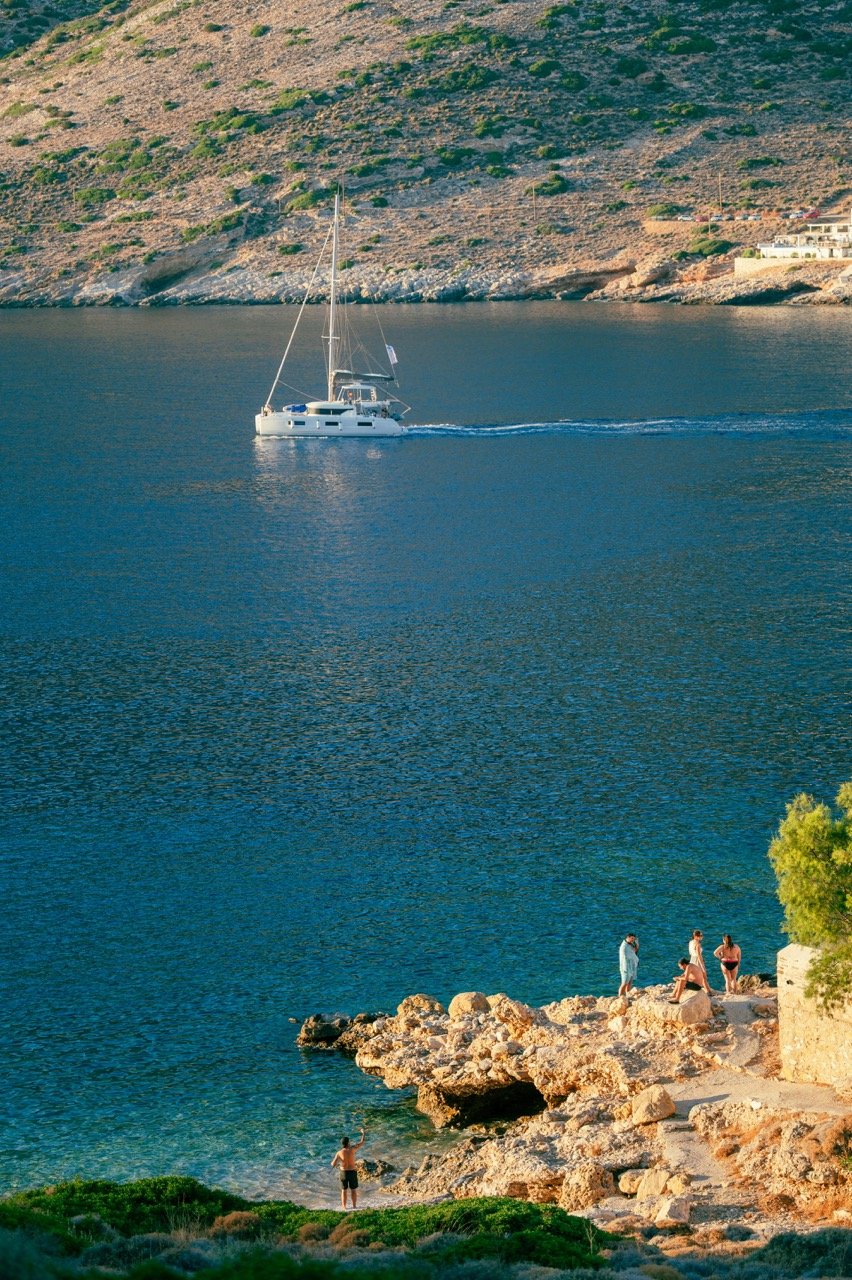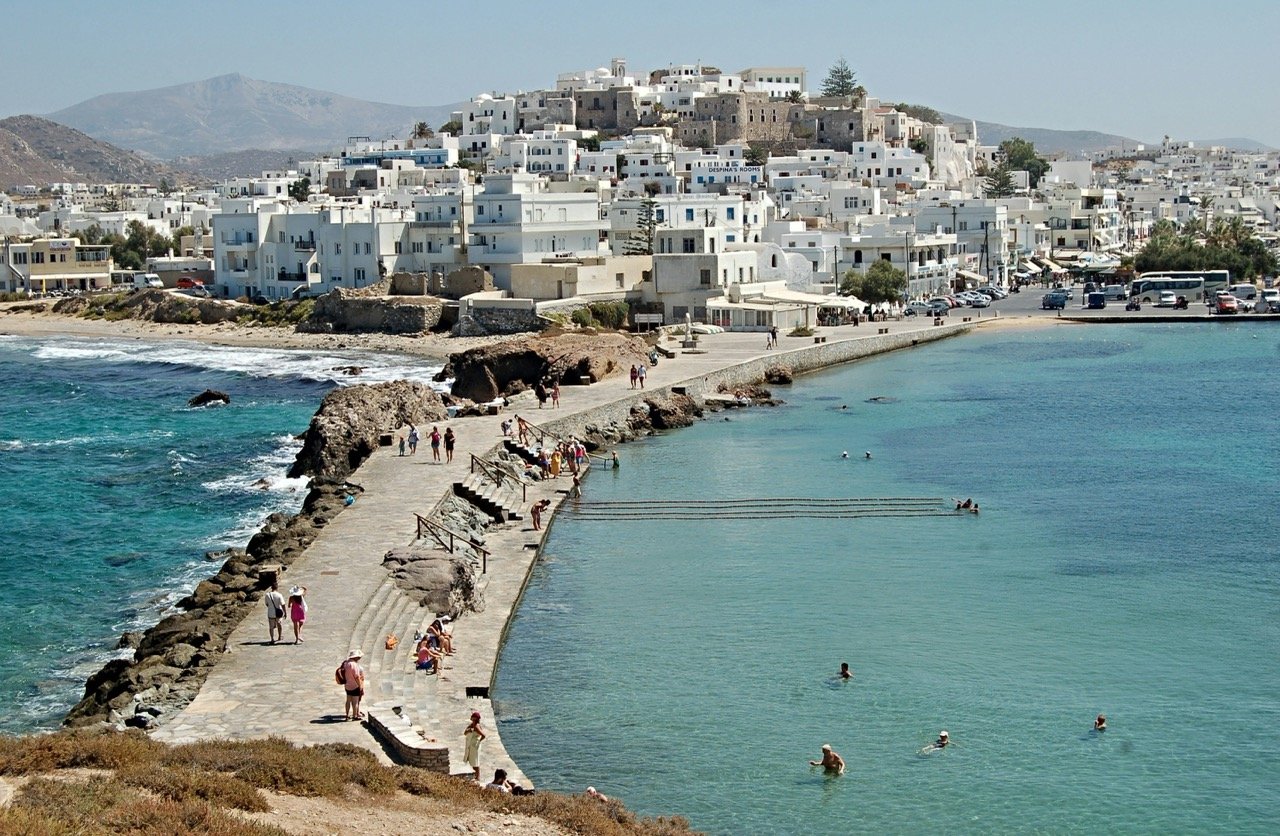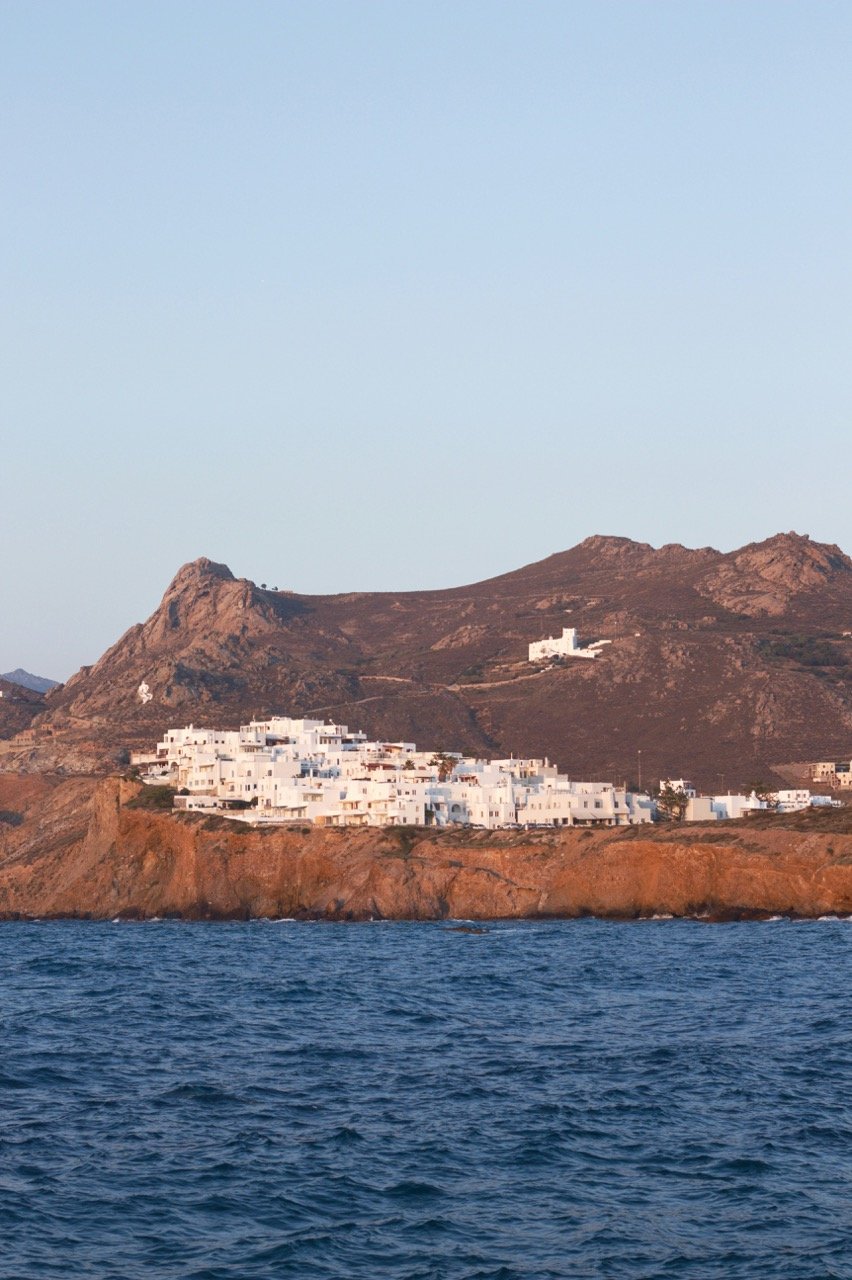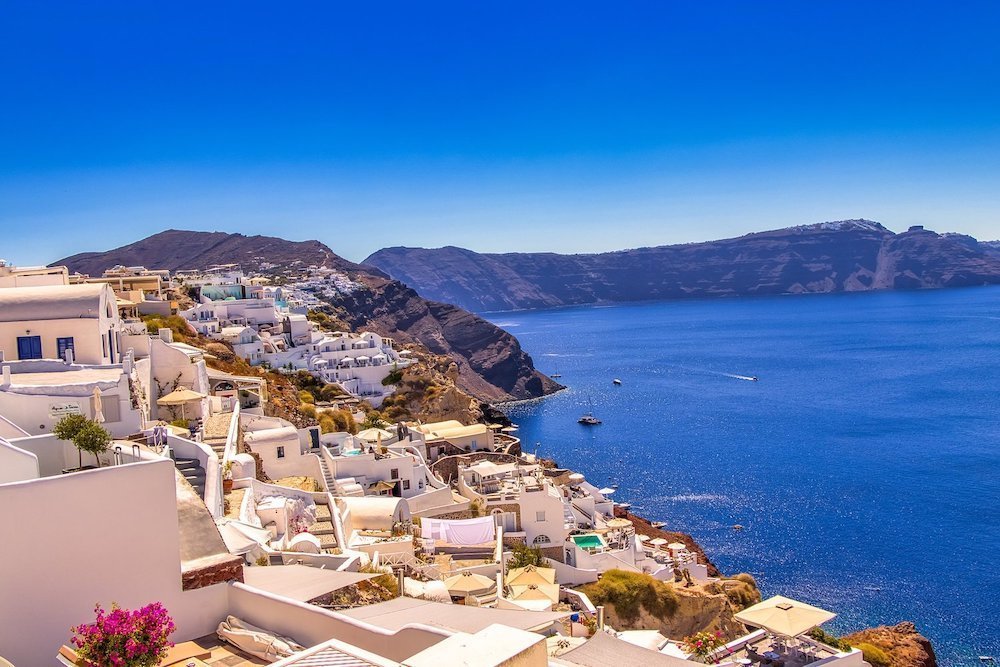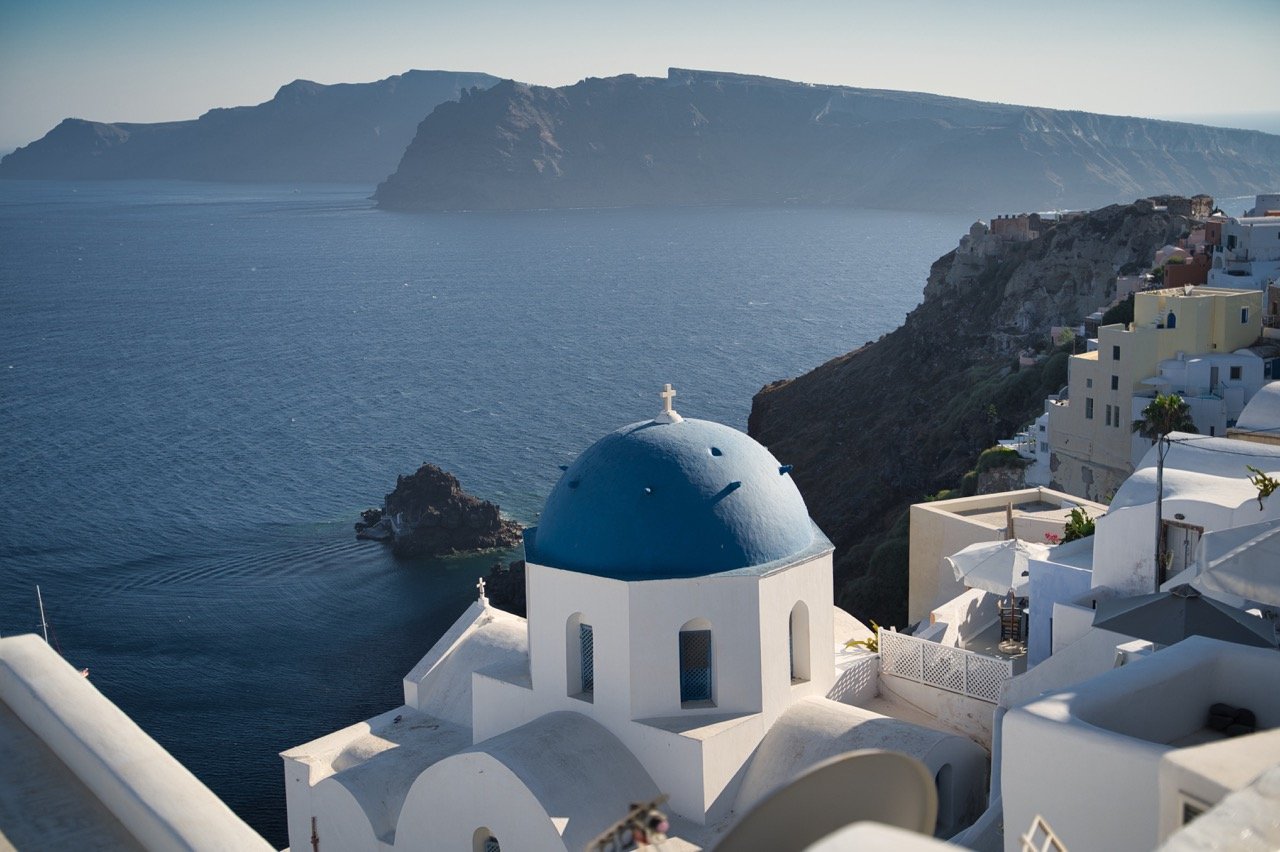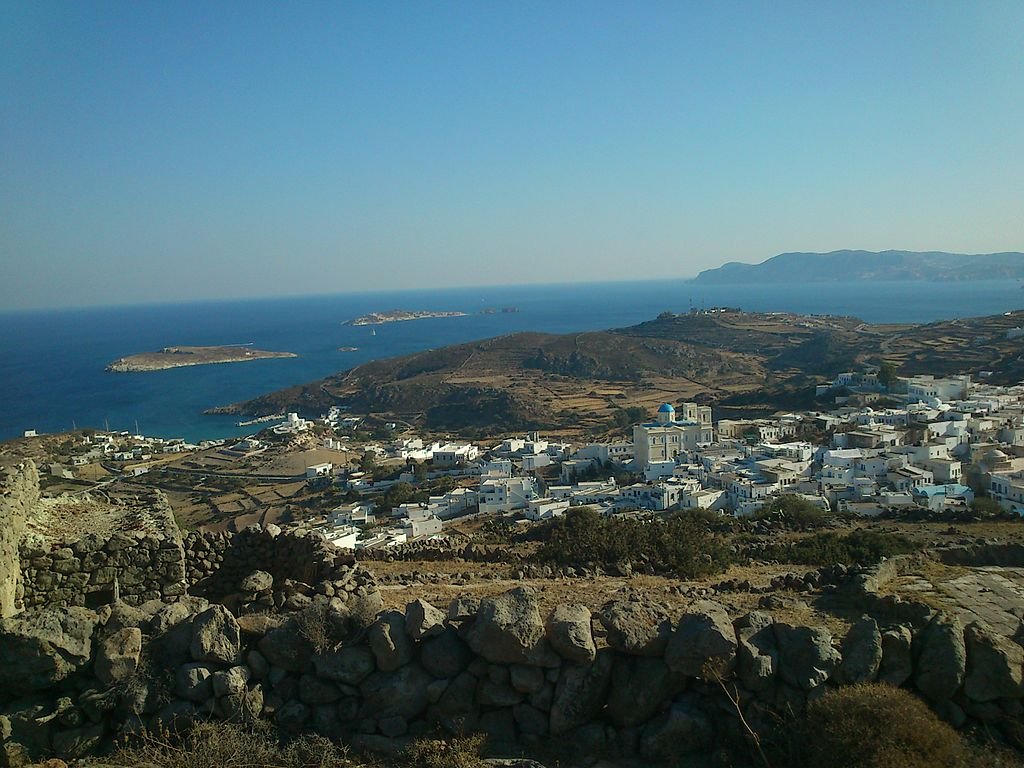A Local's Guide to Travel in the Cyclades Islands
The Cyclades are a chain of 220 Greek islands and islets in the Aegean sea. Out of all those islands, 24 are inhabited. Although there are various different island chains in Greece, when most people say "the Greek islands”, these are what they're really talking about.
The Cyclades contain some of Greece’s most popular tourist destinations - places like Santorini, Mykonos, and Naxos -, but also many almost totally unvisited islands where authentic and slow-paced Greek maritime life is still present.
Spread over a fairly large patch of sea - about 1,000 sq. miles - many islands are quite distinct from one another. For example, Santorini’s volcanic creation makes for striking black sand beaches, rocky soil, and hilly terrain while calmer Sifnos has miles of sandy beaches lapped by serene waters.
You won’t be able to see them all (or even half of them) on any single trip. But that’s the pleasure of the Greek islands - you always have somewhere new to explore!
So, the purpose of this guide is to help you decide on which islands will be right for you, how to divide your time between them, how to navigate ferries and transport, and how to put together a great island-hopping trip.
Let's get to work!
Table of Contents


Where are the Cyclades?
The Cyclades circled in orange. Photo: Eric Gaba (Sting - fr:Sting), CC BY-SA 3.0, via Wikimedia Commons. Cropped from original
The Cyclades are located southeast of Athens, off the southernmost tip of mainland Greece.
They spread out across the Aegean Sea in a southeastern direction, toward Crete (to the south) and Turkey (to the east). Two other island groups are near them: the North Aegean islands and the Dodecanese islands.
In terms of distance from the mainland, the closest island is Kea, which is about 40 minutes from the Port of Lavrio (near to Athens). On the opposite end of things, Santorini, Anafi, and Amorgos are the furthest away from the mainland, with those islands being about 7 to 10-hour ferry rides from Athen’s Piraeus port.
What makes them unique
Compared to the rest of Greece, the Cyclades are quite different from a geological perspective. Their landscapes are characterized by arid, and often barren rocky landmasses and volcanic calderas. While some islands in the complex have low vegetation and even grow some vegetables, there are no tall trees or dense forests.
You’ll find both sandy and rocky beaches, and all of them have clear and cool waters which are perfect for swimming and diving from April all the way through the end of October.
Temperatures are mild for much of the year, and while the summertime does get scorchingly hot, the "meltemia" winds from the north provide a refreshing breeze that makes it feel much cooler, and also clear away clouds and fog, meaning you have perpetually sunny days and great visibility.
Why visit
The obvious answer to this question is: to relax on some of the best beaches in the Mediterranean! But, there's more to the islands than just their beaches.
These littles isles are among the most beautiful places in the Mediterranean and their turquoise waters truly are spectacular. While you could spend your entire trip swimming, boating, and enjoying amazing views, you'd do well to set aside some time for other pursuits too.
For history buffs, the islands are steeped legends and mythology and they have many fantastic Greek ruins to explore. To get outdoors, head into their interiors where you'll find good hiking and biking trails, grab a kayak and explore the rocky coastlines, or go scuba diving or snorkeling.
For sightseeing, be sure to visit the lovely Cycladic villages which are built in an architectural style unique to the islands, and many of which also have remains of Venetian fortresses. The seafood is of course terrific, but the gastronomic delights of places like Sifnos go way beyond just fish. And then there's the unique way of life that's totally distinct from that on the mainland.
And if you want to party, there's nowhere better to be than Mykonos, Ios, or Paros!
So, yes, do come for the beaches, but don't forget about all the rest!
How to get to the islands
By plane
Access to the Cyclades has significantly improved in the last decade, as some of the most popular islands now have airports that are connected with Athens by year-round flights.
Additionally, during the high season, the most visited islands, such as Mykonos, Santorini and Naxos, have frequent direct flights connecting them many major European cities outside of Greece.
Here are the Cyclades islands with airports:
Mykonos
Santorini
Paros
Naxos
Milos
Syros
The airports in Mykonos, Santorini and Paros operate international flights, charter flights, and domestic flights. The rest of the airports operate only domestic flights from Athens.
By ferry
Alternatively, you can fly to Athens and then catch a ferry from any of Athen’s three ports. Piraeus is the port most easy to get to from Athens airport and city center, but depending on where you're going you will also want to look at options from Rafina and Lavrio.
Almost all of the Cyclades Islands are directly accessible from Piraeus by ferry during the peak tourist season in the summer.
While some less popular islands might only have one or two connections per week, the popular tourist islands, like Mykonos, Santorini, Paros, and Naxos, will typically have more than one ferry per day.
There are quite a few ferry companies that operate routes, but the main ones are Sea Jets, Blue Star Ferries, Hellenic Seaways, Golden Star Ferries, and Minoan Lines.
Ferries typically have standard and high-speed service. For those with limited time, it always worth it to spend more and do a high-speed ferry. Overnight journeys are also a possibility and a good way to not lose precious days in transit!
You can book direct with any company, but to save yourself a bit of hassle when searching, I always recommend checking on Ferry Scanner. It’s an aggregator that shows options from a bunch of different ferry companies in one place. It costs a bit more than booking direct, but the difference is pretty insignificant.


How many days to spend
When it comes to visiting the Cyclades, you can never have too much time here. You could visit for months and not see everything, so the honest answer to “how long to visit” is as much time as you’ve got.
However, most people don’t have unlimited vacation time or the budget to swing months of traveling, so I generally recommend 7-10 days as a good amount of time for a first visit to the islands. One of the pleasures of visiting the islands is traveling between them and discovering the varying geographies, cultures, and “styles” of each of them, and you need at least a week to do that.
Of course, island hopping requires taking ferry trips, so you’ll have to set aside some time for travel, which can range from an hour, to 8-10, depending on which islands you’re traveling between.
So, with a week to a week and a half, you’ll have time to comfortably visit anywhere from 3 to 5 islands, which will give you a really nice introduction to this magnificent part of the world.
7 days - the bare minimum
With a minimum stay of 7 days in the Cyclades, we’d suggest visiting 2, or maybe even 3 islands, and choosing ones that are close enough to each other that you won’t be stuck on endless ferry rides, wasting half your trip in transit.
If you opt for bigger islands like Naxos, Andros, or Paros, and you want to experience them to the fullest, then the best choice is to base yourself on 2 islands. You can spend 3 full days on each island, and add in a day trip from one of them to a smaller neighboring island.
Some nice examples include:
3 days at Naxos, 3 days at Paros, & 1 day at Antiparos (close to Paros)
3 days at Syros, 3 days at Mykonos, & 1 day at Delos (close to Mykonos)
3 days at Sifnos, 3 days at Milos, & 1 day at Kimolos or AntiMilos (both close to Milos)
3 days at Ios, 3 days at Santorini, & 1 day at Therassia (close to Santorini)
When you choose your itinerary, make sure that the islands are well connected with ferries in routes that make sense. For example, don’t include in the same 7-day itinerary combinations like Andros and Anafi, Kea and Amorgos, or Serifos and Donoussa, because you will end up having 8 to 10-hour ferry journeys traveling between them.
We put together a detailed 7-day Cyclades itinerary that includes Naxos, Santorini, and Koufonisia.
10 days - for a more relaxed trip
The ideal stay in the Cyclades is 10 days because in this amount of time you can island-hop conveniently between 5 to 6 islands and base yourself in up to 3 or 4 of them.
Some nice examples that will have you visiting 5 to 6 islands include:
3 days on Milos with a daytrip to AntiMilos, 3 days on Paros with a daytrip at Antiparos, 3 days on Naxos, and 1 day on Irakleia
2 days on Andros, 2 days on Syros, 2 days on Tinos, 4 days on Mykonos with a day trip to Delos
3 days on Ios with a day trip to Sikinos, 2 days on Folegandros, 2 days on Amorgos, and 3 days on Santorini
No matter exactly how much time you have, the key point regarding island hopping in the Cyclades is always to choose islands that are close enough to each other that you minimize travel time and maximize your time actually on the islands, enjoying your holiday.
There’s always the option of coming back to, so you should prioritize an enjoyable trip rather than trying to see as many islands as possible.
For a detailed plan, have a look at our 10-day Greek islands itinerary that includes Athens, Santorini, Sifnos, and Milos.
Getting between islands
Transport between islands
Although some islands have airports (as mentioned above), almost none of them offer flights to other islands. So, realistically your only way to travel between them is via ferry.
On the most popular islands, you’ll find ferries arriving and departing as frequently as every hour. However, on less-touristed islands, there might only be two or three vessels arriving and departing each week, so you need to plan your itinerary carefully to line it up with the ferry schedule.
A very important note to all prospective island-hoppers is that not all islands are accessible from other ones. For example, a journey from Sifnos to Milos is a breeze, but getting from Sifnos to Amorgos would be a nightmare. So, when planning an island-hopping itinerary, you need to choose islands that have good connections between each other.
Islands that are "transportation” hubs
The islands with big ports serve as a kind of hub for smaller or neighboring islands. In order to minimize travel times and ensure lots of options, make sure your itinerary includes some of the “hub islands” like Syros, Tinos, Mykonos, Sifnos, Paros, Naxos, Milos, and Santorini.
These islands are well-connected with one another, usually via direct ferry connections which can run as often as multiple times per day during the high season.
Additionally, each of these islands also provides good access to smaller neighboring ones. Here are some examples:
Naxos is well-connected with Koufonissia, Donousa, Schoinousa, Keros, and Irakleia
Santorini is well-connected with Anafi, Folegandros, Sikinos, and Ios
Milos is well-connected with Kimolos, AntiMilos, and Polyaigos
Paros is well-connected with Antiparos
As I mentioned before, I always recommend checking routes via Ferry Scanner.
Transport on the islands
Public transport
While most of the islands do have public transportation, service is generally pretty limited and it’s really not the ideal way to get around.
Places like Santorini, Naxos, and Paros actually have pretty good bus service, but they are the exceptions.
On most islands, you'll find that buses do a decent job of getting you between the main towns and major tourist sights, but service is usually infrequent and buses travel very slowly due to the islands’ hilly terrain and narrow roads.
If you're coming on a long trip and will be spending many days on each island or if you're planning something very relaxed and just want to get out to a couple of beaches and see a town or two, then using the bus is a fine option. For anyone with more limited time and/or hoping to beach hop and visit lots of sights, you will need to rent a car or rely on taxis.
Taxis and ride-share apps
Many of the islands have local taxi services and you can also find local tour operators who can arrange drivers and transfers.
Unlike in big cities, you won’t usually find taxis waiting around at designated locations, so you will often have to get the number for a local taxi company and call them if you want a ride. This is especially true outside of the bigger towns.
If you're trying to catch a ride from more remote areas or beaches, you will almost always want to arrange the service in advance, or call at least a few hours before you want to be picked up.
Apps like Uber don't work everywhere, but you'll find it available on some of the islands, like Santorini.
Your hotel will almost always be able to provide you with contact info for taxis/drivers, but you can also find lots of info with a quick search online.
Renting a car
When I'm island-hopping, I generally rent a car and I really do recommend it. It just opens up so many more possibilities and lets you beach hop and sightsee in a much more efficient manner.
On all of the islands you will find local agencies offering car rentals. Some islands also have domestic and international chains, but you'll typically find the local ones to be cheaper.
In many cases, rental agencies will have someone meet you directly at the island's port on your arrival and they'll either be there with your car or will drive you to the rental location. Most agencies are located right in the port anyways, so you can often just walk to them. In some cases, agencies may even bring the car to your hotel.
If you’re planning on renting a car, I always recommend checking prices on DiscoverCars. It’s a car rental aggregator website that shows options from all the major international companies as well as lots of smaller local ones. You can often find very good deals.
When to visit
Because almost everyone visiting the Cyclades wants to at least spend some time at the beach and on the water, this really is a summer destination. But peak season (mid-June to early September) is still not the best time to come in my opinion.
Visiting in fall (the best)
For me, the best time to visit the Cyclades is from the second half of September through late October (early fall). In this period, you have temperatures that are hot, but not scorching, there's little threat of rain, the sea is at its warmest, and the summer crowds have mostly departed. Prices for everything are also far more reasonable.
The islands don't really start shutting down until November, so if you choose to come in the early fall you'll still find almost everything open and plenty of regular ferry routes.
Also, because this is the tail end of the season, you'll find that locals and just about everyone else you'll meet are a bit more relaxed. They've survived the summer crush and can breather again, so if you're looking to connect with locals, you'll find that people are less rushed and a bit more friendly and open (though Greeks are always!).
Visiting in Spring
If you’re looking for mild temperatures and tranquillity, visiting in the spring (early March until the end of May) can be wonderful.
With mild temperatures ranging from 15 to 27 degrees Celsius and mostly sunny days, the weather is truly perfect. The air is incredibly fresh, the light is good, and the landscapes are beautiful with flowers in bloom and even a bit of green from the winter and spring rains.
On top of that, you can enjoy crowd-free attractions, as most travelers won’t arrive until a bit later in the year, and you’ll avoid the extreme summer heat.
The only thing to keep in mind is that it's often not hot enough for swimming in the spring. Even if the air temperature is good, the sea is typically still pretty cold.
Visiting in summer
If you prefer to come to the Cyclades during the summertime, or if that’s just when your vacation is, you can still have a fantastic experience here. These are islands after all, so of course summer is a great time to be here. There are just some tradeoffs to be aware of, and you have to be better with your planning to avoid the worst of the crowds.
From the beginning of June until the end of August, you’ll have endlessly sunny days, very hot temperatures (with average highs of 32°C), albeit moderated by the Meltemia winds coming off the Aegean Sea, and yes, big crowds.
The summer is high season here, and the Greek islands are famous the world over, so high season most definitely does mean intense, and at times, overwhelming crowds.
Also, anything that you need to reserve ahead of time will book out quickly (boat trips, tours/excursions, hotels, car rentals, etc.) so you need to make reservation in advance. In line with that, prices are also at their highest during the summer.
However, as with any tourist destination, you can always escape the madness and find little untouched gems as long as you’re willing to work a bit. There are few things more rewarding than finding a gorgeous empty beach cove and having it all to yourself while thousands of people crowd together shoulder to shoulder elsewhere!
Expenses and average costs
As a premier global tourist destination, you'll find that for things like hotels the Cyclades have options at all different budgets. That said, high season here is expensive and you should not expect bargain prices. In off season, on the other hand, you may be downright shocked at how cheap things can be.
Accommodation
Rates vary significantly depending on the season and the type of accommodation. In the lesser-known islands, especially during the off season, you can find decent hotel rooms for as low as 30 euros per night. On the other end of the spectrum, summer rates for sea view suites in places like Santorini can run will into the thousands.
A typical rate per night for a 3 to 4-star hotel during the peak season is from 100 to 300 euros.
Meals
Things like a souvlaki or gyro cost just a few euros and the average cost of lunch in a typical Greek taverna is about 25 euros per person. Dinner at a nice mid-range restaurant will cost a bit more, around 30-35.
A reasonable meal at an upscale restaurant with a good bottle of wine could be around 50 euros per person.
Wine & alcoholic drinks
A nice bottle of wine in a typical restaurant will cost 20-30 euros. The house wine, served in a carafe, could be half that. Cocktails usually cost around 8-12 euros. A beer or glass of wine can run from 4-8 euros.
Car rental
From about 30-100 euros per day depending on the season, the size and make of the car, and whether you rent a manual or automatic transmission.
Ferry tickets
Prices start from 30 euros for slower ferries and short routes and can cost up to 150 for fast ferries and longer journeys. There are passenger-only ferries and car ferries, which have different prices as well, and bringing a car is of course more expensive.
Local public transport
Expect to pay about 2 euros for a one-way bus ticket.
Taxi service
10 euros for a short ride.
Entrance tickets to sites
For museums and archaeological sites, tickets range from about 5 to 15 euros per person.
Sunbeds
At beach bars on most islands you'll pay around 15 euros per set of 2 sunbeds and 1 umbrella. On places like Santorini and Mykonos, this could be much more.
Boat cruises
Around 50 euros per person for a small group boat ride. A full-day catamaran ride could cost around 100 euros per person.
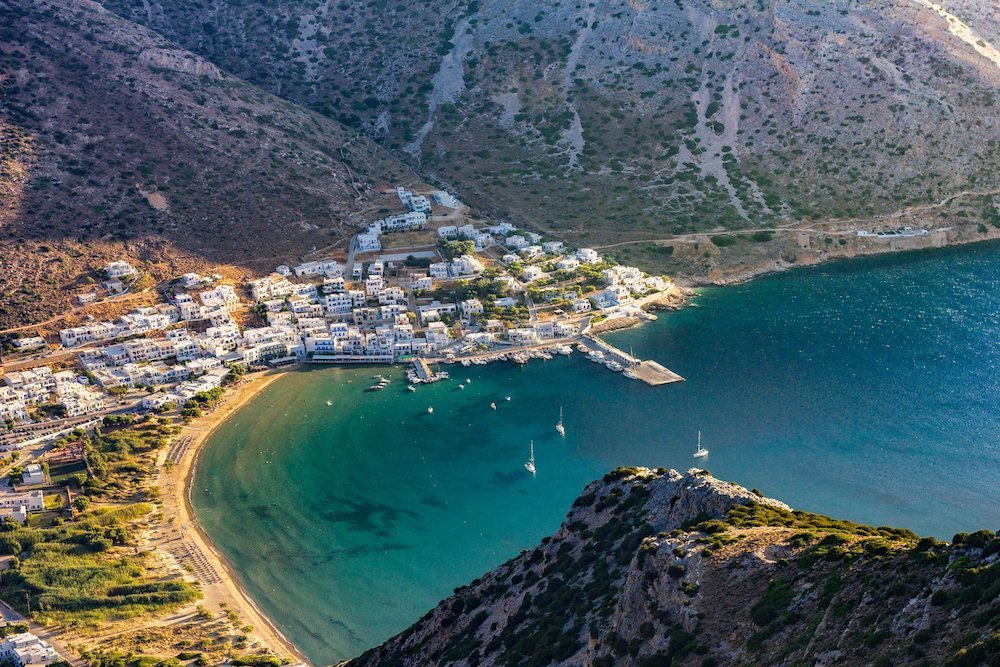
Which islands to visit
While the islands all share some similarities, no two are exactly alike, and each offers its own set of attractions and vacation styles. Because of that, most visitors to the islands try to hop between a few of them, combining the best that each one has to offer.
There’s no right or wrong combination of islands to be included in an itinerary, but if you’re interested in a varied vacation that covers a bit of everything mentioned above, you’ll want to carefully choose a few different islands that offer a taste of each of those activities and attractions.
Another important thing to keep in mind is that you don't want to lose entire days to traveling between the islands, so I always recommend
While I can’t choose the “right” islands for you, I've given quick overviews to 20 of them to help you figure out which might interest you. We have individual guides to many of them, so you'll see links to those in the descriptions.
1. Sifnos
The town of Kamares on Sifnos
Located near the islands of Milos and Serifos, Sifnos is one of my absolute favorite places in the Cyclades and all of Greece. Long a favorite escape for Greek visitors, it become popular in the last decade to international visitors as well.
Sifnos has no airport, so no matter where you're coming, you'll need to take a ferry to get here. From Athens, it takes 2.5-5 hours depending on the type of vessel you book.
Sifnos is the ideal island for anyone seeking a balance of stunning beaches, good, but relaxed nightlife, white Cycladic villages, mild to medium tourism levels, and possibly the best food in the Cyclades.
The island is considered the epitome of Cycladic grace and beauty and despite its tourist popularity, retains an authentic spirit. The landscape is ordinary but stunning, with barren heights and valleys that finish in tiny coves.
Sifnos has many small towns and picturesque villages to visit. The island’s capital is Apollonia, a typical community with white, two-story homes and churches built on the top of a hill. Artemonas, a nearby town with Neoclassical architecture, floral courtyards, and two windmills perched on a hill overlooking the island, is another lovely place to visit.
Don’t forget to visit the Panagia Chrysopigi monastery in the bay of Faros, which is situated on a small peninsula.
Beautiful beaches for swimming are Kamares, Platy Gialos, Seralia, and the outstanding Herronissos.
If you love good food and gourmet gastronomy, the island has a rich culinary history. The majority of traditional dishes are produced with minimal ingredients (typically fresh seasonal vegetables) and gently cooked in a wood oven. Despite these simple ingredients, the cuisine is outstanding. Many dishes are based on vegetables and lentils (a particular delicacy), however there are dishes with fresh fish and meat as well.
Check out our guide to Sifnos for additional info.
2. Milos
The lunar-like beach of Sarakiniko
Rugged coast on Milos
View over Milos from Plaka's castle
The fishermen's village of Mandrakia on Milos
In the southwest of the Cyclades is wonderful Milos, a perennial favorite with both local and international tourists. It's one of my favorite islands to pair with a visit to Sifnos because it's nearby and provides an interesting contrast.
It has a totally unique geologic formation, and its variety of beaches and landscapes is stunning. You'll see many unusual volcanic rocks, often in hues of white, red, pink, and orange, and it's these strange and beautiful formations that give the island its reputation. Milos also has a big coastline with over 40 distinctive beaches, many of them excellent.
It's also one of the more cosmpolitan islands and it's a pretty elegant and refinded place. You have lots of very good hotels, great restaurants, and pleasant bars. It's not snobby or pretentious, but I often call it "well heeled". At the same time, it also does not (yet) suffer from the overtourism you'll find in places like Santorini and Mykonos. It strikes a good balance.
One of few Cycladic islands with an airport, it's accessible by plane or ferry from Athens. You have ferry connections with lots of other islands too.
There are seven main villages here: Adamas, Triovassalos, Tripiti, Plakes, Plaka, Zefiria and Pollonia. The capital of the island is Plaka, one of the most gorgeous settlements in the Aegean. The port of Adamas (sometimes called Adamantas) is one of the largest natural ports in the Mediterranean.
A few must-visits on the island are the archaeological museum (housingartifacts from the Paleolithic Phylakopi as well as a replica of the renowned Venus of Milos statue), the Venetian castle, and the early Christian catacombs at Klima.
And then, of course, there are the beaches, the islands true draw! Sarakiniko, Kleftiko, Papafragas, Achivadolimni, Paleochori, and Fyriplaka are only a few of the island's and the Aegean's finest and most beautiful beaches.
You can read more in our guide to Milos.
3. Naxos
Chora Naxos, the island's main town
Naxos Chora's harbor lit at night
Plaka beach. Photo: G Da, CC BY-SA 3.0, via Wikimedia Commons
Naxos is the largest island in the Cyclades located nearly in the center of the complex. With more than 20,000 permanent residents, the island is also the most productive and self-sufficient. It has a gorgeous coastline as well as a rugged interior, with mountains that rise up to over 1,000 meters in altitude.
There's an airport with domestic flights to/from Athens on a daily basis and excellent ferry connections to mainland Greece and other islands.
Naxos has approximately 40 inhabited villages, each one with its own distinct personality, and many of them are genuinely worth seeing. You have seaside towns, mountain villages, resorts, and a clutch of interesting archaeological sites. There's decent nightlife and a good dining scene. In terms of "things to do” Naxos probably offers the most of any island in the Cyclades, and for this reason it's quite popular, with both Greeks and foreigners.
Naxos Town (or Chora) is the capital and port and it's a busy town of 9,000 - almost half of the island's residents live here. In the entrance of the harbor lies "Portara," the lone fragment of the ancient temple of Apollo. You also have the remains of a Venetian castle that dominate the steep alleys, palaces, and churches of the old town.
Many historic villages may be found in the island's interior, including Filoti, a lovely mountain village with cube-shaped dwellings and stone-paved streets, and Apeiranthos, a mountain village with a strong Venetian flavor in its architecture.
The beaches of Naxos, of course, are equally attractive: Mikri Vigla, Apollonas, Agios Prokopios, Alykos, Panormos are a few of the very many options.
Read more in our guide to Naxos.
4. Kea (Tzia)
The sea in front of Otzias beach in Kea. Photo: Joy Coffman from San Diego, CA, US, CC BY 2.0, via Wikimedia Commons. Cropped from original
The gorgeous island of Kea, also known as Tzia, is located to the south of Attica. Kea is located quite close to Athens, making it a favorite weekend retreat from the Greek metropolis. You can take the ferry from Lavrio Port and be at Kea in less than an hour.
Despite being part of the Cyclades complex, Kea is very different than the rest of the Cyclades islands and you won’t find whitewashed houses and blue domes. Plus, the island showcases much more vegetation than the typical Cycladian landscape does. Ioulida, the capital, is quite vibrant, but there are also some other cute villages to visit like Vourkari, Korissia, and Otzias.
Kea features beautiful organized beaches, such as Gialiskari, Koundouros, and Korissia, and some others that are more remote and absolutely unspoiled!
Villas, houses, and studios are the most common types of accommodations, with apartments and camping facilities providing additional possibilities.
People come to Kea in order to visit an island close to Athens with natural beauty, to dive into the crystal-clear waters of Cycladic beaches, to admire the architecture and explore the history, to enjoy good food, and to get that much needed island vibe.
Kea is largely unknown to international tourists, but it’s quite popular with Greeks of all ages.
It’s capital, Ioulida, is a historic community with intact Cycladic architecture. The ruins of the Venetian castle may be found in the Kastro neighborhood, which was home to the old acropolis.
You can see the renowned "Lion of Kea" outside of Ioulida by continuing your journey at a short distance. This enormous lion was carved into slate sometime around 600 BC.
Don't forget to explore the archeological site of Karthaia, which features the ancient temple of Pythian Apollo that was constructed above the sea (if you enjoy exploring old ruins, of course).
You can read more about in our guide to Kea.
5. Kythnos
Kolona Beach on Kythnos
Kythnos is an incredible destination in the western Cyclades, with wild natural terrain, unusual beaches, and medieval settlements. Because of its proximity to Athens, approximately 2 hours on a ferry from Lavrio port, Kythnos has been gaining popularity as a destination for short vacations and weekend breaks, particularly for travelers who prefer authentic settings.
Kythnos, once only known to Greek visitors, the past few years has started to attract visitors from all over the world, as social media are flooded with images of the iconic Kolona beach.
The Loutra region of Kythnos, also known as Thermia, is famous for its hot thermal springs, where a hydrotherapy center is located.
The island contains several lovely towns with cobbled streets, whitewashed buildings, churches, and windmills, all in addition to its gorgeous hilltop Chora (main town).
When visiting, be sure to check out the stalactite and stalagmite-filled Katafyki cave.
There are also approximately 100 beaches on the island. There are many lovely ones to choose from, but the most well-known is Kolona Beach, where two coastlines are formed by a thin sliver of sand in a breathtaking setting.
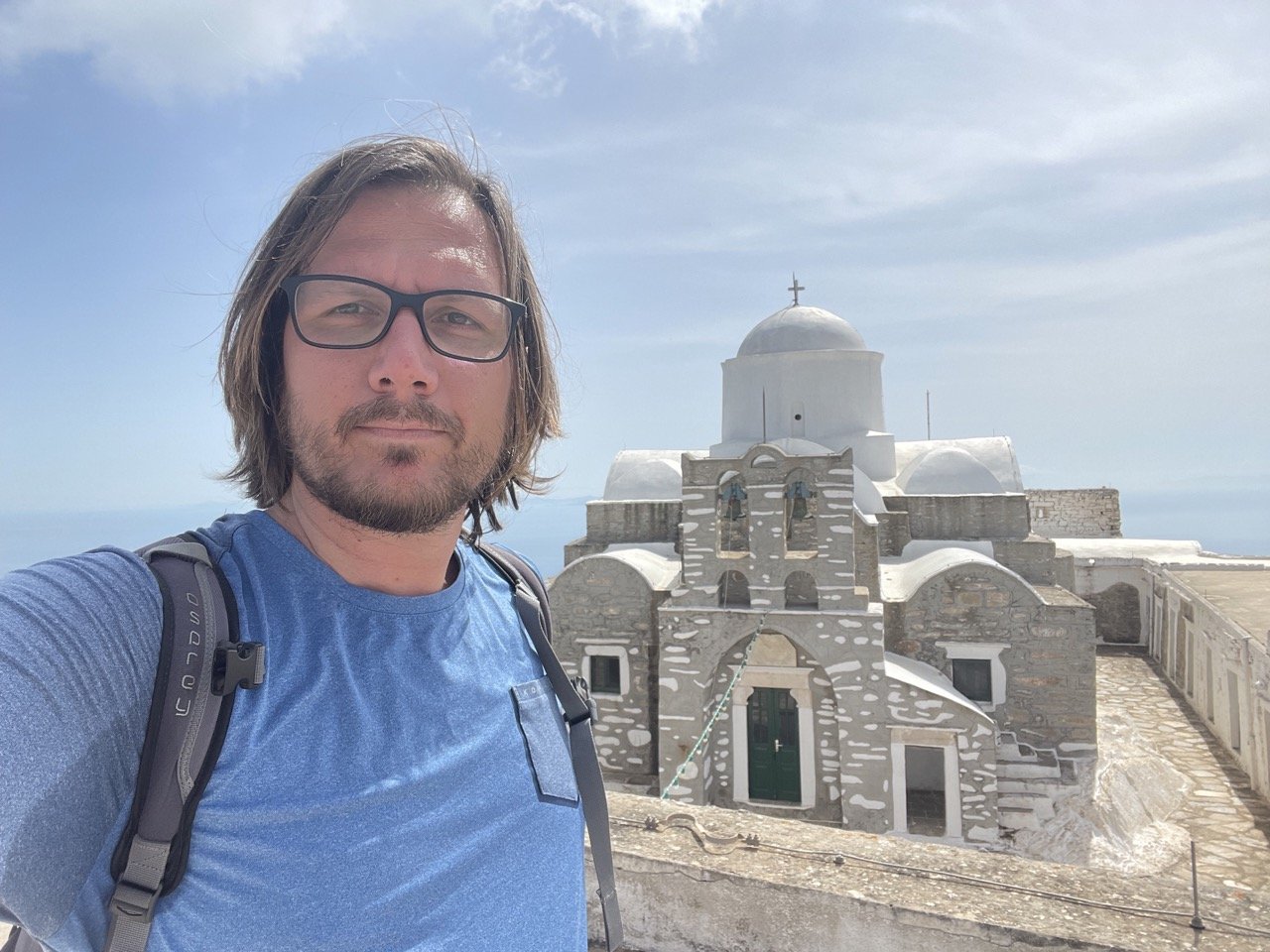

6. Serifos
The main town of Chora on Serifos
Ganema beach
Serifos is a small Cycladian island located between the islands of Kythnos and Sifnos. It is a less-visited island whose beauty remains unspoiled by mass tourism.
In summertime there are daily ferry routes from Piraeus port (Athens) to Serifos and the average journey time is 3 hours.
The island is nearly circular in shape and has seventy-four beaches all around its shoreline. The vast number of beaches are varied in their appearance and characteristics including beaches with pebbles, rocks and golden sand as well.
The large number of beaches and the relaxed island living is the main reason to visit, and it's mostly Greeks who come, looking for a more authentic and rustic escape.
Serifos unquestionably boasts one of the Cyclades' most untamed landscapes, with alternating mountain ranges, lush valleys, and both secluded and wide-open bays.
With its lovely characteristic Cycladic architecture, the main town on the island, Chora, which is constructed amphitheatrically on a hill, is truly charming. Apart from Chora town, Serifos has 5 very picturesque villages worth visiting.
For expansive vistas, be sure to climb up to the town’s Venetian fortress. The historic mines on the island are a unique feature; Megalo Livadi even has an outdoor mining museum.
Lastly, the beaches of Serifos are of unique beauty the most well-known of which are Lia, Koutalas, Vagia, Ganema, Kalo Ambeli, Psili Ammos, and Sykamia.
For more info, see our guide to Serifos.
7. Santorini
The town of Oia and its famous windmills
Clifftop Fira
A view from Oia
I didn't want to mention it right away because everyone has already heard of it, and also because, if I'm being honest, it's not my favorite island.
Located in the far south of the Cyclades and close to the islands of Amorgos, Anafi, and Folegandros, Santorini is one of the most visited paces in Greece. With just 16,000 permanent residents, it receives more than 3 million visitors every year. A “hidden gem” it most definitely is not.
Now, I don't want to sound overly negative as Santorini is quite unique and its towns and coastline are genuinely beautiful. There is a good reason that it was known in antiquity as Kallístē, meaning "the most beautiful one".
The towns of Santorini's western edge hang off the edge of cliffs, overlooking the famed caldera and offering some of the best views and sunsets of anywhere in the world. Towns like Oia, Imervogli, and Firostefani are absolute stunners and also have some of the best hotels in Greece.
In terms of transportation, Santorini is the most accessible of the Cyclades islands, with an airport that receives flights from mainland Greece as well as a host of European capitals as well as a port that connects to many islands and also receives cruise ships.
Although many visitors never leave the caldera towns (or even the private, clifftop pools of their hotel rooms) there's actually a lot more to do on Santorini than just enjoy the views and see a few pretty towns. Excellent white wine (Assyrtiko) is grown in the hilly interior and you can tour vineyards and do tastings, you have some interesting archaeological sites, there are decent black sand beaches on the eastern coast, and there are fabulous boat tours, among other things.
One thing to always keep in mind is that the beaches here are, by Greek standards, rather basic. Santorini is not an island you come to for the beaches.
In terms of who visits the island, the answer is pretty much everyone. If it's your first time in the Cyclades, it makes sense to want to visit. However, because so many people come, the island is completely overrun in high season. To avoid a potentially unpleasant experience, I recommend visiting in Spring or Fall when the weather is still good, but the crowds are much smaller.
I don't have a guide to the island, but I did write an article on where to stay in Santorini.
8. Kimolos
Chorio, Kimolo's main town. Photo: Roza24, CC BY-SA 4.0, via Wikimedia Commons
The pretty town of Psathi. Photo: Nikitas277, CC BY-SA 3.0, via Wikimedia Commons
Kimolos is an interesting island near to Milos that is also volcanic in its makeup. It's smaller in size, but no less stunning. Despite this, it receives a fraction of the visitors of its larger neighbor, almost all of whom are Greeks that want peaceful vacations away from the crowds.
It has virgin beaches, a picturesque Chora/main town called Chorio, and some lovely landscapes. Visitors tend to concentrate in Chorio and the town of Psathi where most of hotels and restaurants are located.
Chorio is made up of two settlements: the ancient Mesa Kastro (which is now in ruins), and the slightly more recent Exo Kastro, whose homes were constructed in the shape of a castle. A stroll through the dome-adorned winding lanes and whitewashed homes is very charming.
The island's beaches are beautiful, including Hellini (where you can view an ancient city submerged in the water), Prassa (which has thermal spas), Aliki, and Bonatsa.
Like Milos, there are pretty little fishermen's villages that feature the colorful syrmata huts/warehouses, some of which have been converted into hotels and guesthouses.
To get here, your only options are ferry, with routes to/from Athens and Milos.
9. Delos
The ruins of a Greek amphitheater in Delos. Photo: Bernard Gagnon, CC BY-SA 3.0, via Wikimedia Commons
The Terrace of the Lions in Delos. Photo: Bernard Gagnon, CC BY-SA 3.0, via Wikimedia Commons. Cropped from original
Ruins in the "Theater Quarter” on Delos. Photo: Bernard Gagnon, CC BY-SA 3.0, via Wikimedia Commons
Delos is located in the center of the Cyclades islands and this center position shaped the name “Cyclades”, as the rest of the islands in the complex are cyclically located around Delos. The island is an archaeological site that played a major role in ancient Greek history, both spiritually and politically.
Delos was preserved almost intact through the centuries due to the fact that it remained uninhabited since the 7th century AD and due to its remote location. Nowadays, the entire island is designated as an archaeological site and as UNESCO world heritage site.
Access to Delos is only through a day trip from a nearby island, there is no direct ferry connection from Athens. Most often the point of departure for Delos day cruises is Mykonos, but there are also day trips to Delos from the islands of Naxos and Paros.
Delos is visited by international and Greek travelers that want to explore the archaeological treasures of the island. Birthplace of Apollo and Artemis, Delos was in ancient times a very important cult center and seat of the Delian Alliance.
Today, visitors can admire the ancient theater, the temples of Artemis and Isis, the Street of Lions with the five marble lions-guards and the sacred Phoenicia where Leto was held while giving birth to Apollo.
There’s also an archaeological museum with rich exhibits, such as sculptures, mosaics, vases, inscriptions and funerary statues.
10. Mykonos
Mykonos’ “Little Venice"
Elia Beach. Photo: Squirmy2000 at English Wikipedia, Public domain, via Wikimedia Commons
Mykonos is located in the northern part of the Cyclades, relative close to Athens and near to Syros, Delos and Tinos. It has an area of only 90 sq km, making it a rather small island.
Most famous for its nightlife and beach parties, Mykonos is very much a young person's island. If you're looking for tranquility, authenticity, or nature, it is not the island for you. But if you're looking to party, dance, sip cocktails by the beach, and mingle, it might be your thing.
Like Santorini, this is one of the most visited islands in Cyclades and one of the easiest to get to. There's an international airport that has daily flights to Athens as well as lots of European capitals. For international flights, you typically won't start seeing availability until the spring and summer. You also have access via ferry from Athens and many other islands.
Despite it's reputation as "just a party island”, Mykonos does have some real appeal even away from the DJ sets.
The island's capital (Chora) is undoubtedly one of the most attractive in the Cyclades with whitewashed cobblestone lanes, white houses with colored doors, windmills, and antique churches. The Castle quarter, which is constructed on a hill above the harbor, as well as the famed Little Venice, an old neighborhood with houses of wealthy merchants and captains, are also both lovely.
You also have some excellent beaches. In the west there's Tourlos and Agios Stefanos; in the east you have Ornos and Agios Ioannis; then there's Platis Gialos and Psarou in the south; and of course world famous “Paradise” and “Super Paradise" too. These are genuinely some of the best beaches in the islands.
Finally, don’t forget to visit the Armenistis lighthouse, from where you will witness a spectacular Aegean sunset.


11. Andros
Photo: G Da, CC BY-SA 3.0, via Wikimedia Commons
Andros is the northernmost island in the Cyclades and the 2nd biggest island in the complex after Naxos. Despite its proximity to Athens, the island has remained relatively unaffected by mass tourism, retaining a more relaxed and authentic vibe.
The ferry crossing from Athens to Andros takes approximately 1 hour and 55 minutes on most ferries servicing this route, although it might take a bit longer depending on the vessel. The island has three main urban centers: Batsi, Andros Town, and Korthi, followed by many smaller villages that are also worth visiting.
The island is mainly popular amongst Greeks but also features a substantial percentage of international travelers, although the overall number of tourists is sustainable and not at all overwhelming.
The beaches of Andros are one of the main reasons that visitors choose this lovely island. Organized or unspoiled, virgin or vibrant, this island has beaches for all preferences. The most well known are Agios Petros, Batsi, and Golden Sand but if you opt for virgin and isolated beaches, consider Vlychada, Agios Sostis, and Halkolimnionas.
One more exciting activity at Andros is hiking, as the island is filled with trekking paths of all difficulty levels, suitable for amateurs and experienced hikers alike.
Andros displays a different image from the one we typically associate with the Cyclades, due to its rich maritime culture.
The Goulandris Museum of Contemporary Art is the showpiece of the impressive Chora, which also impresses with its arches, hills, churches, and palaces of shipowners and captains.
The plane trees in Cairo Square, Afanous Navti Square, and the small island with the Frankish castle that is connected to the mainland by a stone bridge are a few of Chora's most picturesque locations.
Traditional apartments, studios, hotels and suites, and villas with breathtaking views are available for your stay.
12. Tinos
Tinos town (Chora) right on the water
The town of Kardiani. Photo: Stepanps, CC BY-SA 4.0, via Wikimedia Commons
Tinos is at the heart of the Cyclades islands, close to Andros, Mykonos, Syros and Delos. It is the 3rd largest island in the complex after Naxos and Andros, occupying about the same area as Paros, but is much more mountainous.
The island has more than 8,000 permanent residents and a total of more than 50 inhabited villages. Athens to Tinos ferry duration can range between 3 hours 30 minutes and 4 hours 50 minutes depending on the operator you are sailing with and the type of the vessel.
The island's church, Panagia Megalochari, is one of Greece's most popular religious pilgrimages. Every year, people from all over the country flock to this imposing church to worship the miraculous icon of the Virgin Mary, which is housed there.
Every year, on August 15th, when the Virgin Mary is honored, there are numerous celebrations throughout the island, ranging from feasts to large-scaled culinary festivals!
Apart from the religious interest, Tinos is also visited for the picturesque villages and the pristine beaches, mostly by Greeks but also from international visitors although in lower proportion.
Overall, the island offers a more laid-back experience except at the time around the 15th of August, when it tends to be fully booked. There are many hotels and apartments scattered around the island, offering quality accommodation for all budgets.
The island of Panagia and the marble sculptures, Tinos, is a place of special charm. In the capital which is also named Tinos, apart from the white houses and narrow streets, you will also find the famous church of Panagia which was built in 1823 after the icon of the Virgin Mary was found.
The villages of the island are true Aegean jewels: the green Kardiani with its beautiful view, the enchanting Ysternia with its marble-paved alleys, the bustling Pyrgos with museums dedicated to local marble sculptors (such as the Halepa Museum in honor of the famous Tinian sculptor Giannoulis Halepas), the picturesque Panormos with its fresh fish, Falatados with its winding narrow streets, and Kalloni with its gardens and olive groves.
13. Syros
The elegant capital of Ermoupolis
Ermoupolis. Photo: Hans Peter Schaefer, http://www.reserv-a-rt.de, CC BY-SA 3.0, via Wikimedia Commons
Syros is the most populated island of the Cyclades with 20,000 permanent inhabitants and also the most cosmopolitan in a non-touristy sense. It's close to Tinos, Mykonos, Delos and Paros.
Although it has an airport with domestic flights to Athens, it's much more common to arrive via ferry, with the journey on a fast ferry taking just two hours.
Once home to Greece's principal port, Syros was a wealthy place for much of its history and there are 30 villages on the island. Many of them feature lovely architecture, with the capital, Ermopoulis, particularly lovely. In Ermoupolis, colorful homes, neoclassical buildings, merchants’mansions, massive orthodox churches, and lovely squares are always a treat to explore. The town is also an interesting place with some good museums, cultural centers, galleries, and a nice dining scene.
Away from the towns, the coastline is quite nice with especially nice beaches on the southern side of the island. The beaches here feature golden sand, and warm, crystal-clear shallow waters that are ideal for children.
The gastronomy and sweet delicacies like Chalvadopites and Loukoumia are also a yummy “attraction” for visitors.
I quite like Syros and think it's a great option for travelers who want to say somewhere close to Athens and that has a bit more "going on” in a cultural sense.
You can read more about it in our guide to Syros.
14. Paros
The town of Naoussa
Alyki Beach. Photo: Tango7174, CC BY-SA 4.0, via Wikimedia Commons. Cropped from original
Paros is the 2nd largest island in the Cyclades, located between the islands of Sifnos and Naxos from which it is separated by a channel about 8 kilometers wide.
Getting here is easy as there's a domestic airport and loads of ferry connections.
One of the most popular islands in the Cyclades, Paros has a good range of beaches, a clutch of villages, a mountainous interior with good hiking, and buzzing nightlife. It’s a favorite among younger visitors.
Parikia, the capital, is a typical Cycladic village with small cobblestone alleys, white buildings, and lovely churches. The charming harbor of Naoussa, once a pirate's den, has whitewashed houses and is full of restaurants, bars, and clubs.
If I'm being perfectly honest, Paros is far from my favorite island and it's not somewhere that I typically recommend unless you're young, traveling with a group of friends, and looking to party. In terms of beaches, nature, culture, and gastronomy, I think there are many islands that have more to offer, and with far fewer crowds.
Must-visit beaches include Kolymbithres with its impressive rocks, Chrysi Akti, Santa Maria, Pounta, Kalogeros and many others.
For more info, check out our guide to Paros.
15. Antiparos
Photo: Dimorsitanos, CC BY-SA 3.0, via Wikimedia Commons.
Antiparos is a small yet picturesque island to the west of Paros. Despite its proximity to Paros, Antiparos is less busy and has a more sophisticated vibe. There is no direct ferry from Piraeus Port to Antiparos, so in order to access the island you must take a ferry to Paros first.
At Paros, you can take a small passenger ship that will take you to Antiparos in about 30 minutes. Alternatively, you may fly from Athens to Paros and then take this passenger ship to Antiparos.
The Chora of Antiparos, the main village on the island, also known as Kastro, is the capital of the island and is built around a Venetian fortification. Most hotels, restaurants, bars and taverns are nestled at Chora. To the west, on the hill of Agios Ioannis, is the spectacular Antiparos cave, which is richly ornamented with stalactites and stalagmites.
The island's lace coasts will delight even the most demanding beach seekers: Psaralykes, Sifneiko, Soros, Glyfa, and Apandima are just a few of the lovely beaches with pure blue waters.

16. Folegandros
Folegandros’ seaside Chora
Folegandros is a relatively small island but it offers wild, beautiful scenery that dry, stark, and barren, creating a great contrast with the azure waters all around it.
The island is located between Milos, Sikinos and, Santorini and is accessible only by ferry.
Despite its closeness to Greece's most famous island (Santorini), Folegandros remains a relatively "under the radar” place to visit. Sparsely populated and rather wild in its interior, the island has just 3 main villages, Chora, Karavostas, and Ano Meria.
Definitively sleepy and slow-paced, this is not somewhere you go looking for nightlife or a buzzing social scene. Instead, Folegandros is for those looking to enjoy gorgeous Cycladic scenery and quiet beaches away from the tourist masses. Although not "touristy”, Folegandros is also no secret, so you'll still find other travelers, good hotels, and lots of nice restaurants.
Named after Minos' son, Folegandros is an island full of authentic Aegean beauty. The Chora is half built inside the medieval castle on the edge of a steep cliff, with the houses acting as a fortified enclosure, while the newer part is typically Cycladic, with white houses with colorful porticoes and courtyards, cobbled streets and churches. While here, don't forget to stop by Ano Meria, which has an excellent folklore museum.
Beaches for swimming include Karavostasis, Livadi, Agali, and Agios Georgios Bay. Many of the beaches are pebbly, with quite a few accessible only by hiking or boat.
Learn more in our guide to Folegandros.
17. Sikinos
Sikinos is a small, hidden island-gem that encompasses unparalleled beauty. It is regarded as one of the most isolated Cycladic islands, unaffected by tourism development. Its capital city and towns are built in ancient Cycladic style, and its untouched beaches create a soothing environment.
The island is accessible by ferry from Piraeus with routes operating 3 times per week. The duration of the ferry trip ranges from 6.5 to 8.5 hours, depending on whether you choose to travel with high-speed or conventional ferry.
Sikinos is Folegandros' alternative neighbour, modest, unspoiled, and traditional. Chora is separated into two sections: the older Castle with its narrow lanes and historic homes, and the Village with its distinctive Cycladic aspect. Most hotels are located at Chora and at the port, Alopronia. The island is home to about 300 permanent inhabitants.
Sikinos is ideal for travelers that want to relax and totally unwind in a stunning landscape that is complemented by beaches with bright-blue and ultra-clear waters with minimum human intervention and absolute tranquility.
There are three impressive windmills at the top of the Castle's hill, as well as the Monastery of Zoodochos Pigi or Chrysopigi, which offers an unrivaled perspective. The Black Cave, one of the largest caves in the Cyclades, is located underneath the monastery and is only accessible by sea.
18. Ios
The harbor of Ios. Photo: Charles Haynes, CC BY-SA 2.0, via Wikimedia Commons
Ios is the Cyclades' eighth-largest island. It has a land area of 108 square kilometers and an 87-kilometer shoreline. The permanent population is 2.300 people, with many of them working in the tourism industry.
You can reach Ios by ferry from Athens and from many other islands, especially of the Cyclades. All three ports of Athens are connected with the port of Ios. However, most visitors prefer to take a ferry from Piraeus or Rafina. The ferry crossing from Athens to Ios takes approximately 5 hours and 45 minutes on most ferries operating this route, although it might take much longer depending on the operator and the type of vessel.
The island is mostly popular to international travelers of younger ages due to its party ambience but in the last few years, it has also developed a more luxurious profile as one of the most premium resorts in Greece has opened and upscaled the total look and feel of the destination.
Chora in Ios, also known as Ios Town, is the island's largest and only real settlement, located on the western side of the island, two kilometers from the harbor. As an alternative to the Chora, Ormos where the main port is located is also a very picturesque village.
Ios, or Nios as the locals call it, is a beautiful island famous for its nightlife. Beyond the countless bars and endless parties, the island has many other beauties.
Chora is built amphitheatrically on the slope of a hill, at the top of which dominates the volume of the medieval castle. It is an authentic Cycladic state, with white houses, streets and churches.
If you are interested in historical monuments, go to the archaeological site of Skarkos, which was rewarded for its excellent restoration and elevation, as well as the remnants of the ancient city on the hill of Chora. If you appreciate castles, don't miss Paleokastro, a Byzantine-era citadel that guarded the maritime passages from Constantinople to Crete.
Noteworthy beaches include Mylopotas, Magganari, Agia Theodoti, and Psathi for those looking to mix swimming with pleasure.
19. Amorgos
Photo: Oliwan, CC BY-SA 3.0, via Wikimedia Commons
Hozoviotissa Monastery. User: (WT-shared) Teddy at wts wikivoyage, CC BY 3.0, via Wikimedia Commons
Amorgos is the easternmost and seventh-largest island of the Cyclades close to the neighboring island complex of the Dodecanese. It is surrounded by the islands of Naxos, Santorini and Astypalaia from the Dodecanese.
The island is accessible by ferry from and the travel duration is between approximately 5.5 hr and 9 hr. This depends on the type of vessel, the weather conditions as well as the intermediate stops of each itinerary.
The island became famous to the international audience after it was used as a filming site for the 1988 film "The Big Blue," starring Jean Reno, thus it is visited every year by travelers from all over the world that seek an authentic Cycladian-style vacation paired with the privacy and tranquility offered by this untouched by mass tourism destination.
The inhabited settlements of Chora, Aegialis and Katapola are amongst the prettiest in the Cyclades and most hotels and restaurants are located around these areas.
Amorgos stands out for its authentic Cycladic landscape and the immersive environment. Chora, built on the hill where the ancient castle once stood, is full of small uphill lanes, white cottages with wells and fountains, windmills, and historic churches, all with a spectacular outlook.
The monastery of Hozoviotissa, erected on a high cliff, is unquestionably the jewel of the island. You'll have to climb 300 high steps to get there!
Find more Amorgos travel info in our guide to Amorgos.
20. Anafi
Mount Kalamos. Photo: Mlzs, CC BY-SA 4.0, via Wikimedia Commons. Cropped from original
Anafi is a very small, peaceful and quiet island in the Cyclades that has a population of 330 inhabitants. Located near the southeastern end of the Cyclades, rather isolated from the rest of the islands, Anafi offers amazing scenery for nature-lovers and tranquility seekers.
The island is only accessible by ferry. There are ferries from Piraeus port in Athens and is also connected with Santorini and other islands. There is a ferry connection between Anafi and Piraeus port, approximately 3 times per week, however the trip is a long one, taking a total time of about 9 to 10 hours.
Chora, Anafi's only settlement and capital, is perched on the slopes of a mountainside and surrounded by lovely chapels. Another little village is rapidly emerging around the harbor, complete with summer homes and some lodging.
The island is mostly visited by Greeks as it is not really known to the international audience. Anafi offers a range of accommodation options for visitors, from budget-friendly guesthouses to luxurious villas.
Chora is a charming little state constructed on the ruins of the Venetian fortress, with little white buildings with courtyards, uphill alleys, small squares, churches, and windmills.
The old city sprawls out on Kasteli hill, which is home to enormous tombs and sepulchral sculptures. Don't miss Kalamos, the highest monolith in the eastern Mediterranean, which is especially popular with experienced climbers.


More Greece travel info
For more advice on planning your trip to Greece, have a look at some of our other guides and itineraries!
Cyclades islands
Athens
Greece


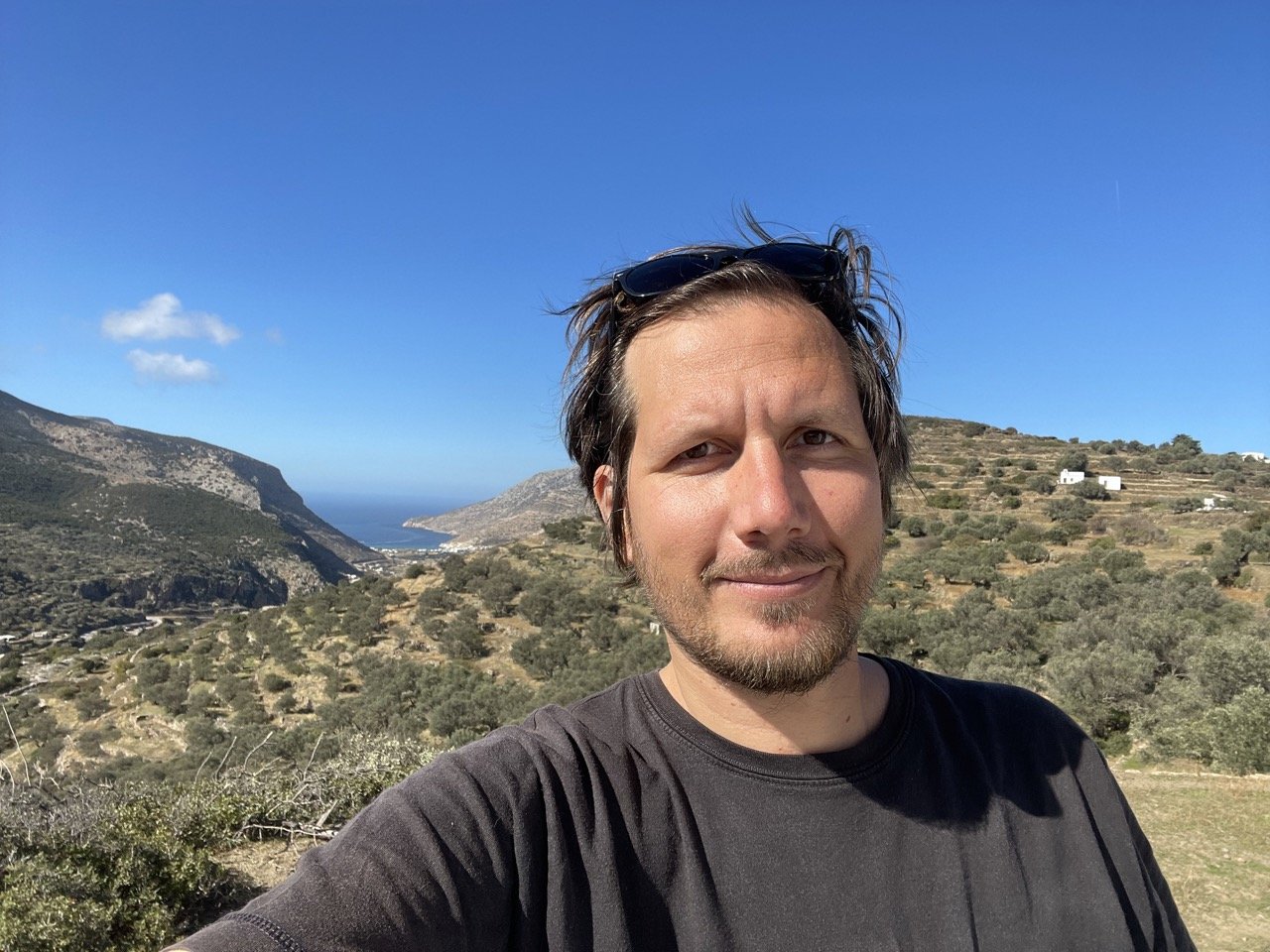
Connect with a Local Expert






